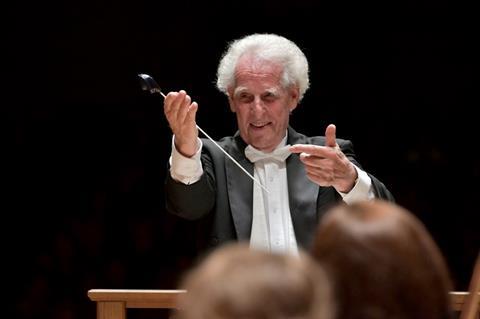Ahead of a performance with the Boston Philharmonic Orchestra at Carnegie Hall on 26 February, the conductor reflects on tempo choices and character in this monumental work

Discover more Featured Stories like this in The Strad Playing Hub
The biggest decision facing a conductor preparing a performance of Beethoven’s Ninth Symphony is whether to follow his clearly stated and fervently advocated metronome marks. Beethoven had no doubts. When he was told that the first performance of the Ninth in Berlin was a huge success, he snapped: ’That’s because they followed the metronome marks!’
When his tempi are followed, the experience of the piece is totally different from the ’traditional’ Romantic performance. My own recording with the Philharmonia Orchestra runs at 58:40 minutes, while Riccardo Muti’s with the Chicago Symphony runs at 79 minutes. Where did those 20 minutes go?
Well, listen to his recording at one passage from the first movement - the Fugue from the Development bar 218 at MM=66 and the Boston Philharmonic at 84.
Ricardo Muti and the Chicago Symphony:
Benjamin Zander and the Boston Philharmonic Orchestra:
Surely, Beethoven would have favoured the unrelenting fury and ferocious nobility of the second rendition, which is why he marked the movement to be played at 88 (one notch over our live performance).
George Solti takes 20 minutes to perform the slow movement with his Chicago orchestra, while my Philharmonia recording takes a little over eleven! As I prepare the performance with my own Boston Philharmonic in Carnegie Hall on 26 February, I am aiming to create a more calm and spacious atmosphere than I managed in my Philharmonia recording. Without abandoning fealty to Beethoven’s tempo indications, I will use more freedom, tempo rubato, and a lighter string sound. Interestingly, the metronome marking for the slow movement of the Ninth is identical to that of his string quartet op.59 no 2. Both movements, which should be felt in two, are marked Adagio molto, crochet = 60 (meaning 30, since the lowest number on Beethoven’s metronome was 50). Was that a coincidence, or did Beethoven know exactly what he was doing?
I recently invited a BPO violinist to play through the piece with the Persian/Italian pianist Alessandro Deljavan. Violin and piano reductions of symphonies were a common way for amateur musicians to learn the symphonic repertoire in the days before recordings. Our music cupboard at home was full of them because my father played them regularly. On this occasion, both musicians were sight reading, but you can sense a totally different approach to string playing in Matt’s playing - light, elegant, free, and warm without weighing down the tone with too much vibrato. This is the kind of sound my teacher, the great Spanish cellist Gaspar Cassadó made and which I try to elicit from the strings of the Boston Philharmonic. If you tune in on 26 February, you will see if we can get that same light approach with the full strings (16 14 10 12 8).
Solti, in a Wagnerian Dreamworld, bent on plumbing the emotional and spiritual depths of the music, takes the tempo twice as slow as Beethoven indicates:
Incidentally, if you haven’t heard the incomparable Cassadó, you can hear him playing Chopin’s Eb Nocturne, which is the sound I grew up on during my five years as his student, and which I have tried to inculcate into the Boston Philharmonic string DNA - obviously, in 1927, performed on gut strings.
Finally comes the issue of the two tempi in the Ninth that seem to present unreasonable demands on even the most able professional string players - the Trio of the Second Movement and the Alla Marcia at letter K in the Finale. On the recording with the Philharmonia, both tempi are rendered exactly and anyone interested in delving deeper can listen to my discussion of the March and the Trio on my Philharmonia CD
I am convinced that Beethoven intended both these movements to go extremely fast, but I haven’t yet decided if I am going to pull back slightly from the excoriating tempos of these two sections for the February performance.
When Ignaz Schuppanzigh, one of the day’s leading violinists, complained of a difficult passage, Beethoven is reputed to have retorted:
’What do I care about your damned fiddle, when the Spirit seizes me!’
One wonders how string players in the orchestra in the first performance in 1824, which, like the Boston Philharmonic, contained some accomplished amateurs, would have managed such tempi. However, the main thing, as always in Beethoven, is not the TEMPO but the CHARACTER. Both these sections are marches, one a traditional march like the British Grenadiers (at MM=116), the other, a glorious ceremonial march at around 84, with a plume in the hat, the knees lifted high, and the proud legs prancing.
The Boston Philharmonic Orchestra performs Beethoven’s Symphony no.9 at Carnegie Hall on 26 February. For additional information and Live-stream access, please visit: https://www.bostonphil.org/concerts/2022-2023/bpo3-beethoven9-carnegie
Read: Cellist Gary Hoffman on Brahms, bowings, fingerings, and finding the perfect tempo
Watch: Beethoven Symphony no.5… for solo violin!
Read more Featured Stories like this in The Strad Playing Hub











































No comments yet